A successful English course should, in particular, help learners speak English, accurately and fluently. Most English courses try to spread the language learning into four skills: reading, writing, listening and speaking which is ok if you have many years to dedicate to learning the language. However, if the student can demonstrate a good grasp of the speaking skill, that student will usually have good results with the other skills.
Therefore, the most important concept for the language learner and the teacher is that the student must speak English and communicate throughout the lesson. In order for the teacher to help the student make progress, he or she must provide opportunities for the student to speak. In turn, the teacher must also speak clearly and listen attentively to what the student says.
Ok, that said, what does phonetics have to do with speaking English effectively?
The term “language” has many different meanings. Listen to this:
The systematic creation and usage of symbols and sounds is an essential manifestation of language. Each of these factors, the symbol or alphabet, and the correspondent sound is regulated through social conventions differing from language to language.
Many languages use sounds which try to correspond to their alphabet. For example in the Italian language, spelling and pronunciation go hand in hand. Consider the words:
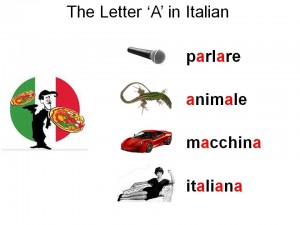
They all contain the letter A, which is always pronounced in the same way.
Now consider some English words:
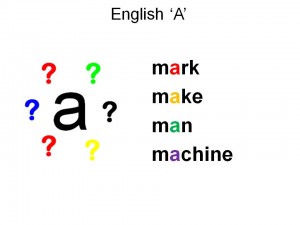
They also contain the letter A, as far as spelling is concerned – but what about the pronunciation? Mark, make, man, machine. There are a total of four As, but they’re all pronounced differently.
The International Phonetic Association – IPA for short– has created a series of symbols – the phonetic alphabet – which we can use to indicate precisely the pronunciation of these words.
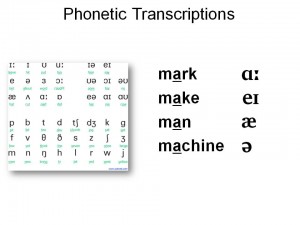
Each symbol represents one and only one sound. An A with two dots after it is a long AH sound, as in our first word, mark. The vowel sound of make is actually a double vowel or diphthong – make – and is represented by a composite symbol: make. Man contains a vowel sound that we transcribe with a sort of curlicue symbol: man. And finally, the A in the word machine is pronounced as a very weak, indistinct sound represented by an upside-down E: machine…
Another problem for learners is that many letters in the spelling of English words are not pronounced at all.
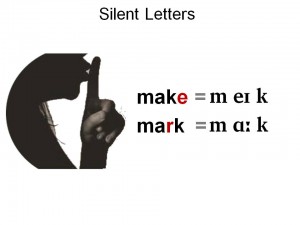
Consider our word make . The E at the end is silent, so it does not appear in the transcription.
Something similar happens in the word mark – though this may come as a surprise if you’re from Scotland, Ireland, the U.S. or Canada! The R in this word is not pronounced at all in the conventional pronunciation that is reflected in usual British transcriptions: mark…
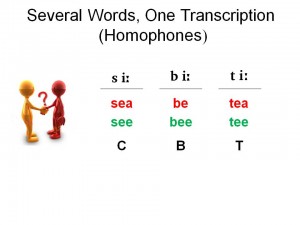
Consider these words: the noun sea, as in the Mediterranean Sea; the verb to see, and the name of the letter C, or a musical note, as in middle C. These words are pronounced exactly alike; therefore they have the same phonetic transcription, even though the spelling is quite different.
Some more examples are the verb to be, the honey-making insect, bee, and the second letter of the alphabet, also a musical note, B. Likewise tea that you drink, a tee that a golfer uses, and the letter used in spelling these words, T.
As you can “see”, the phonetic symbol for the vowel sound in all of these words is an I followed by two dots.
Some letters found in the spelling of words become superfluous in the phonetic transcription.
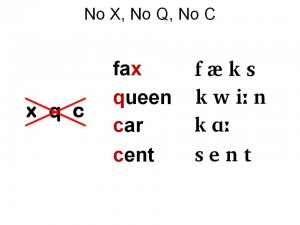
For example, the letter X as in fax is really a combination of the two sounds K and S: fax…
The letter Q, followed by U, as in queen is transcribed into phonetics by K and W: queen…
A hard C, as in car, is transcribed with a K: car… But a soft C, as in cent, is represented by an S: cent…
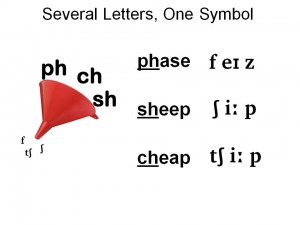
Some combinations of letters in the spelling – such as PH, SH and CH – actually represent a single sound. For example, the PH of phase has the sound of an F phase… And, by the way, notice how the S in this word is transcribed!
Some words are represented by symbols that do not correspond to normal letters of the alphabet. The initial sound of the word sheep, for example, is represented by a sort of stretched-out S: sheep…
For CH as in cheap we find a combination symbol that begins with a T: cheap…
Now let’s examine a complete transcription of one of our first example words, machine:
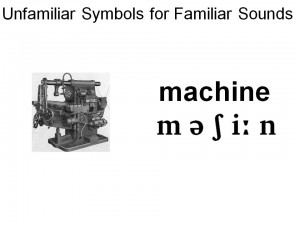
Only the initial M and the final N are normal letters of the alphabet. The three phonetic symbols in the middle may still look a bit strange to you, but the sounds they represent are perfectly familiar: machine…
I hope that I have been able to demonstrate how a phonetic transcription can be used to indicate precisely the pronunciation of English words, and also to show you some of the ways that the transcription can differ from the actual spelling of the word.
Always bear in mind, however, that the transcriptions we use reflect just one variety of English – which most likely does not correspond one hundred percent to the way any of us actually speak.
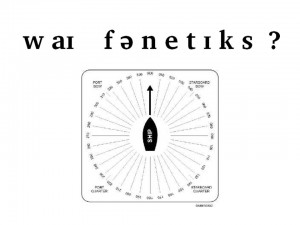
So… why do we use it? Because the phonetic alphabet provides teachers and students with a single, common point of reference that we can all use for the complicated business of teaching –and learning – English.
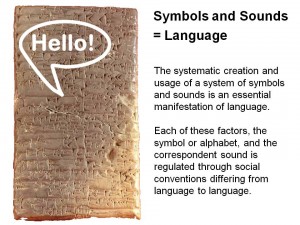
It’s really very interesting and useful for the teachers who teach linguistics.The video clearly shows the mechanics of speech.the relationship between the symbol and the sound.
It’s very interesting and for the teachers who teach linguistics.and specially for non native speakers
thnaks a million. it is so usefull
you have whatsapp